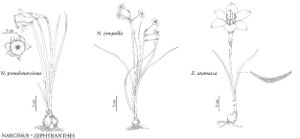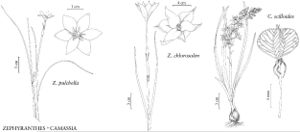Zephyranthes
Appendix, 36. 1821.
Herbs, perennial, scapose, from bulbs. Bulbs black or brown, tunicate, ovoid or globose, sometimes with long neck. Leaves sessile, erect or recumbent, with overlapping sheathing bases; blade linear, rarely exceeding 1 cm wide, smooth. Scape hollow. Inflorescence 1-flowered (rarely 2-flowered in Z. drummondii), spathaceous, otherwise ebracteate; spathe proximally tubular. Flowers erect to declinate, actinomorphic; perianth subrotate to funnelform to salverform, connate basally into tube, 2–16 cm; tepals subequal; stamens 6, of 2 different lengths, appearing equal or subequal (anthers in 2 overlapping sets of 3) to unequal (anthers of the sets not overlapping in Z. longifolia); filaments inserted just above perianth-tube, erect, diverging except when shorter than tube, long-filiform to short-subulate, those inserted on distal tepals usually 1+ mm longer than those inserted on proximal ones; anthers submedially dorsifixed, usually parallel with floral axis, linear-oblong; ovary inferior; style filiform; stigma capitate or 3-fid with lobes linear; pedicel sometimes absent, hollow. Fruits capsular, thin-walled, 3-locular, subglobose or ± oblate. Seeds numerous, black, flat, D or wedge-shaped, lustrous. x = 6.
Distribution
se and sc United States, Mexico, West Indies, Central America, South America
Discussion
Species ca. 70 (16 in the flora).
In Zephyranthes, the degree of fusion of the perianth into a tube is reflected in flower form, filament length, staminal position, and the opening of the bud. Flowers with much-abbreviated perianth tubes are subrotate; with increasing degrees of perianth fusion, flower form shifts from subrotate to funnelform to salverform. The more the perianth is fused, the shorter the filaments in relative length. The longer the perianth tube, the less the stamens diverge, to the point of fasciculation. The timing of the opening of the bud and the expansion of the flower runs across this morphological spectrum from early morning (shortest tubes) through the day to the evening (longest tubes).
The phylogeny of Zephyranthes is not well understood. The species with long perianth tubes and fasciculate stamens are sometimes segregated in the genus Cooperia. While there is considerable diversity within Zephyranthes, splitting the genus into two genera by the degree of fusion of the perianth tube does not fit well with the continuity of the morphological spectrum and with the apparent hybrid origins of species in Texas and Mexico. By and large, species with linear stigmatic lobes bloom mid winter–spring–summer, while those with capitate stigmas bloom summer–fall. Many species with linear stigmatic lobes have leaves over 5 mm wide, but such wide leaves are not known in species with capitate stigmas. Whether there is particular generic significance in differences in stigmatic lobes (linear or capitate) or in filaments (filiform or subulate, and apically acute or blunt) remains to be discovered.
The perianth tube as a portion of the perianth, the relative lengths of the filaments and perianth tube, the type of stigma, the spatial relationships of the stamens, and the position of the stigma relative to the anthers are critical characteristics in the separation of species of Zephyranthes. These characteristics, especially the capitate stigma, can be very difficult to determine in herbarium specimens, but reasonable determinations can usually be achieved with strong backlighting and practice. For consistency, almost all measurements given herein are from herbarium specimens. The width of the leaf shrinks in pressing and drying; generally the maximum width of a fresh leaf could be about one and one half that reported here.
It has been thought that pedicels are consistently either present or absent in species of Zephyranthes. This is belied by the occurrence of both pedicellate and sessile flowers within each of the three species (Z. atamasca, Z. treatiae, and Z. simpsonii) native to the southeastern United States.
Selected References
None.
Lower Taxa
Key
| 1 | Stigma capitate. | > 2 |
| 1 | Stigma 3-fid. | > 9 |
| 2 | Perianth white, sometimes tinged pink. | > 3 |
| 2 | Perianth yellow. | > 5 |
| 3 | Perianth tube shorter than spathe, shorter than filaments. | Zephyranthes candida |
| 3 | Perianth tube longer than spathe, longer than filaments. | > 4 |
| 4 | Stigma exserted 2 mm or more beyond anthers. | Zephyranthes traubii |
| 4 | Stigma among or very near anthers. | Zephyranthes chlorosolen |
| 5 | Perianth tube shorter than filaments. | > 6 |
| 5 | Perianth tube longer than filaments. | > 7 |
| 6 | Stamens in 2 distinctly subequal sets. | Zephyranthes citrina |
| 6 | Stamens appearing equal. | Zephyranthes pulchella |
| 7 | Perianth tube longer than spathe, more than 7 times as long as filaments. | Zephyranthes jonesii |
| 7 | Perianth tube usually shorter than spathe, less than 6 times as long as filaments. | > 8 |
| 8 | Perianth tube ca. 2 times as long as filaments. | Zephyranthes refugiensis |
| 8 | Perianth tube ca. 3–5 times as long as filaments. | Zephyranthes smallii |
| 9 | Perianth yellow. | Zephyranthes longifolia |
| 9 | Perianth white or pink. | > 10 |
| 10 | Stigma included within perianth tube. | Zephyranthes drummondii |
| 10 | Stigma exserted beyond perianth tube. | > 11 |
| 11 | Anthers 13–22 mm. | Zephyranthes grandiflora |
| 11 | Anthers 8 mm or shorter. | > 12 |
| 12 | Perianth tube 0.4 cm or shorter. | > 13 |
| 12 | Perianth tube 0.8 cm or longer. | > 14 |
| 13 | Perianth rose pink; distal tepals not erect; stamens in 2 slightly subequal sets. | Zephyranthes rosea |
| 13 | Perianth white, sometimes flushed pink abaxially; distal tepals erect; stamens in 2 distinctly subequal sets. | Zephyranthes insularum |
| 14 | Stigma very near, among, or below anthers; perianth tube 1/3 or more as long as perianth. | Zephyranthes simpsonii |
| 14 | Stigma exserted more than 2 mm beyond anthers; perianth tube 1/3 or less as long as perianth. | > 15 |
| 15 | Perianth tube less than 1/4 as long as perianth, ca. 1/2 as long as filaments. | Zephyranthes atamasca |
| 15 | Perianth tube 1/4 or more as long as perianth, ± equaling filaments. | Zephyranthes treatiae |
"wide" is not a number."thicker" is not a number.

